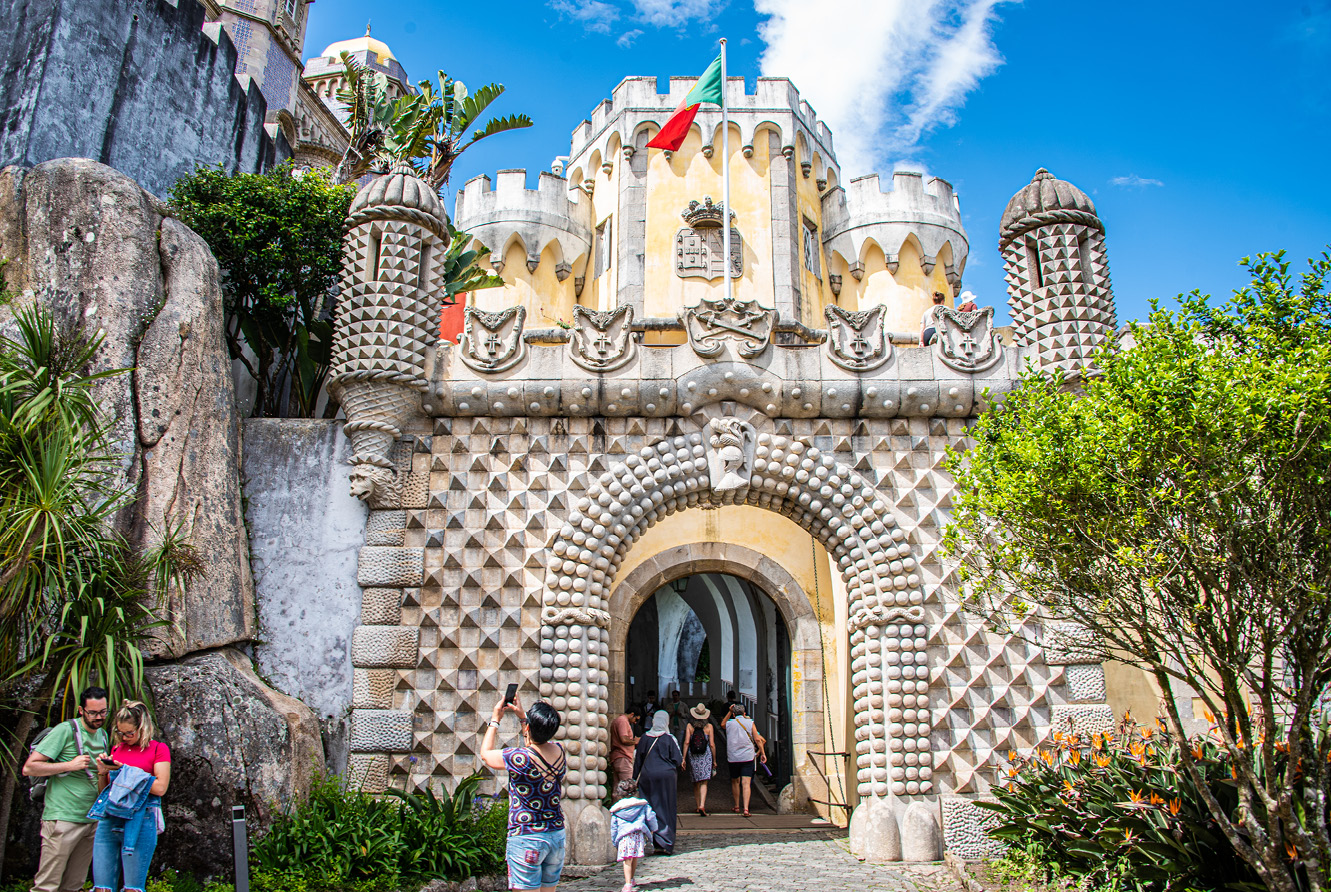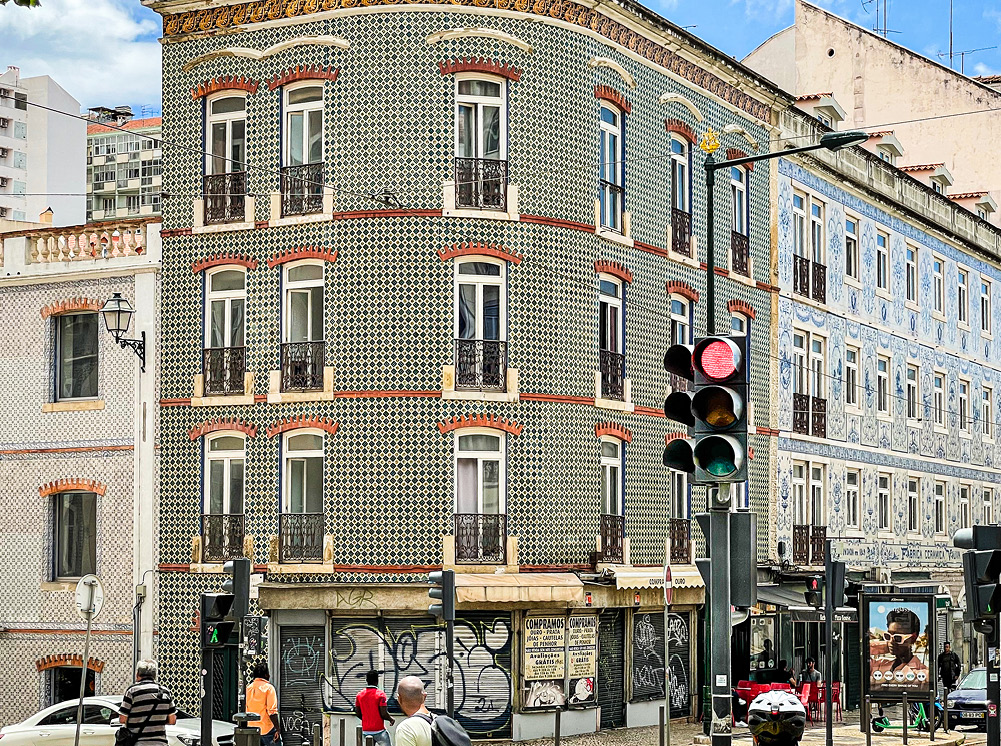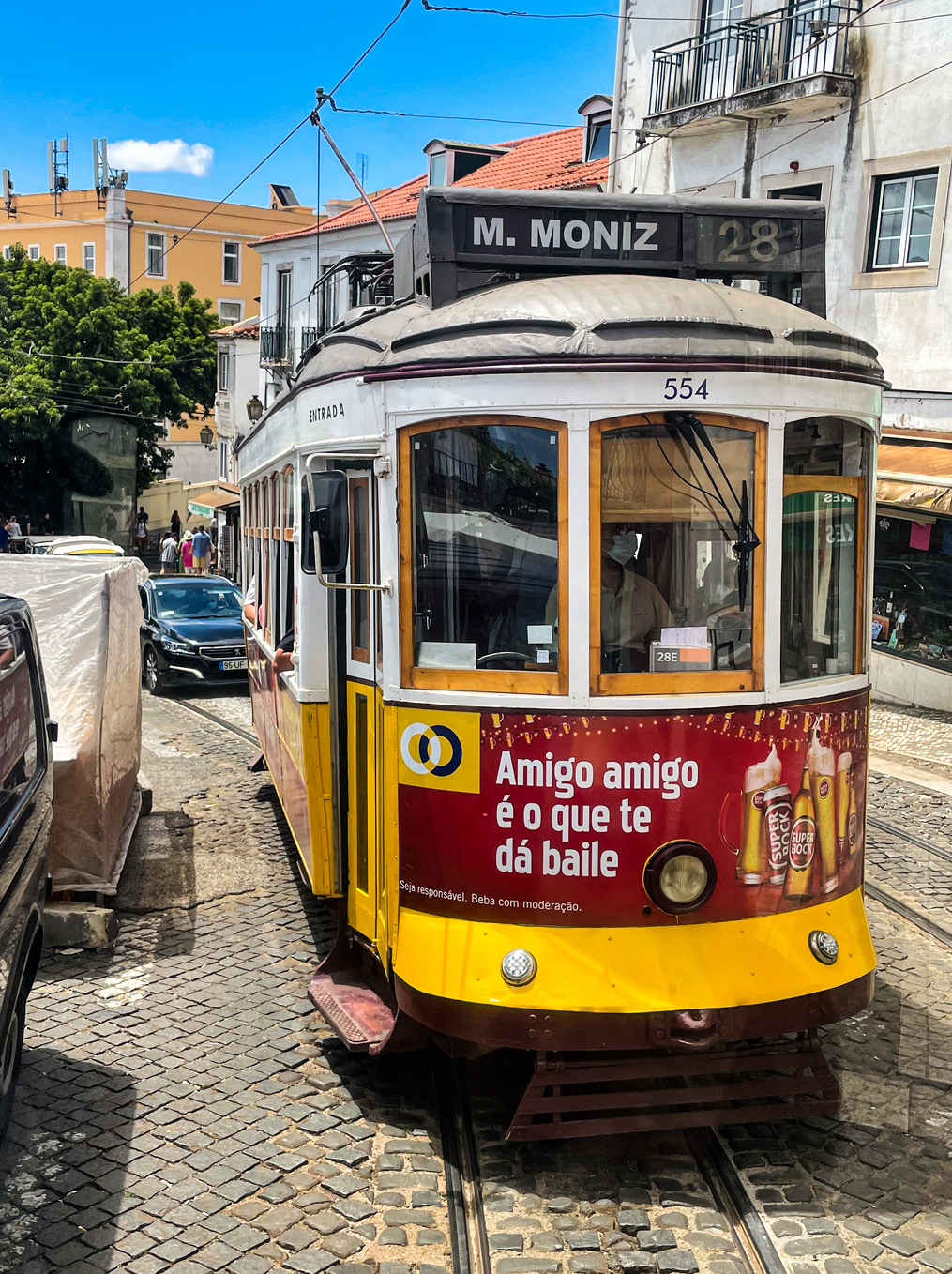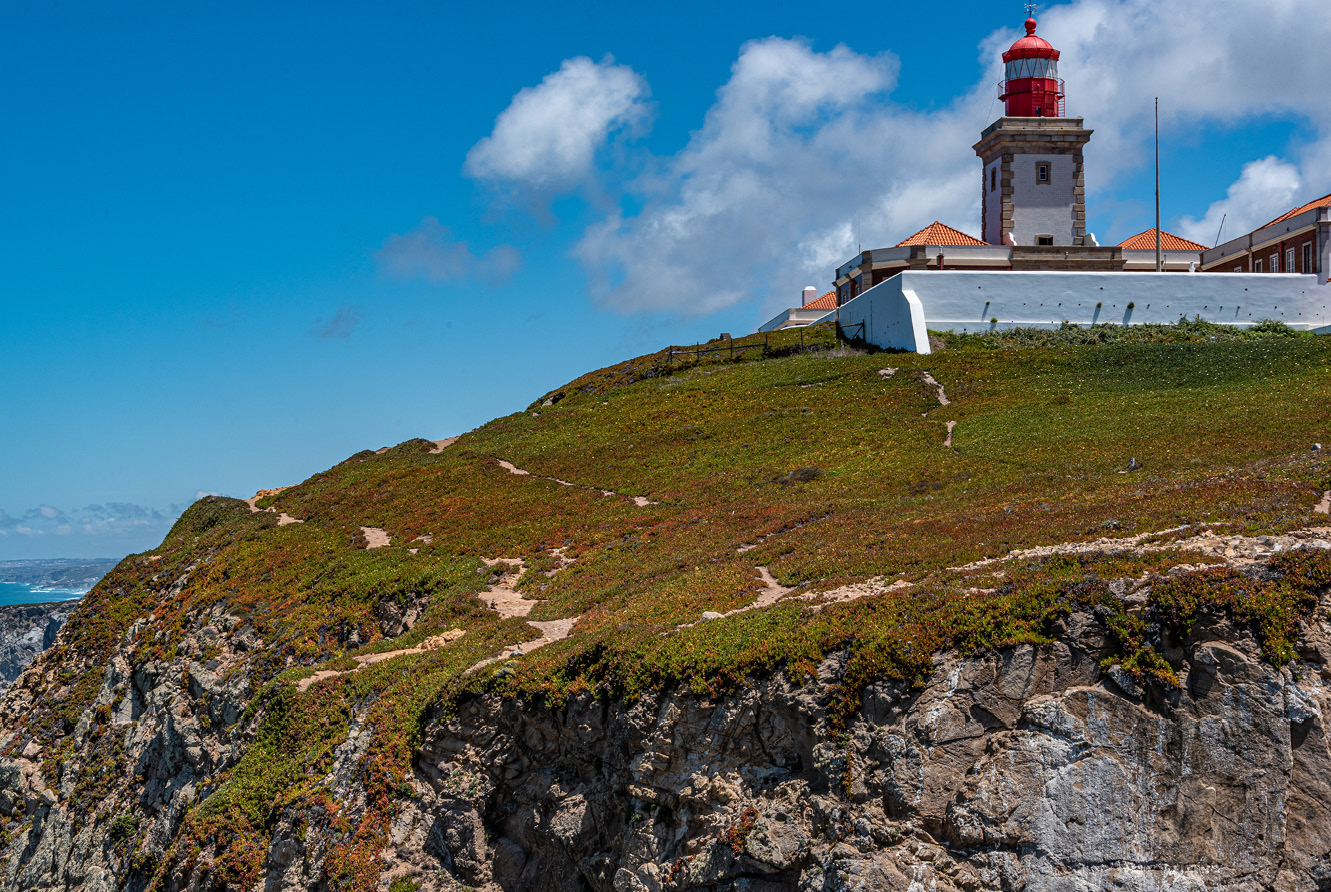Pictured above: Lively Praça Camões (or square) in Lisbon’s Chiado neighborhood, invites tourists, shoppers, and workers to relax and enjoy the scene. A bronze statue of Luis de Camões, Portugal’s greatest and revered poet, oversees the square’s activities.
Before I travel to someplace new, I pour over guidebooks, read travelers’ reviews, absorb its history, anticipate new regional dishes, and learn a little of the local language. Somehow, I still wasn’t prepared for Portugal’s unhurried ambience, its genuine friendliness and cultural sophistication, its rich and handsome architectural history, and its diverse natural beauty. After spending years on page two of European travel destinations, Portugal emerged in the last decade to claim its rightful place as a travel headliner.
I arranged the trip through KimKim, a top-rated online travel agency, who hooked us up with local travel experts Tiago Filipe and Joël Oliveira, who operate My Lisbon Holidays tour company. They helped to plan an 11-day on-the-ground itinerary for northern Portugal, make all reservations, rent a car, and guide us in Lisbon. Those eleven days flew by.
Walls and Sidewalks Are Lisbon’s Signature Landmark
What’s Lisbon’s equivalent to Paris’ Eiffel Tower, London’s Big Ben, or Rome’s Colosseum? I found out quickly: it’s on the walls in front of me and sidewalks under my feet—azulejos and calçada portuguese.
Sidewalks aren’t the first thing I usually notice when I visit a place. But when I stepped out of our hotel in the Marqués de Pompal neighborhood on arrival day, the sidewalk immediately captured my attention. All sidewalks in old Lisbon are paved with small, squarish, creamy white basalt and limestone hand-laid tiles. If that’s not eye-popping enough, the sidewalks also display black-tiled creative mosaics in myriad designs of ribbons, flowers, lattice, scallops, and especially those visually distorting waves on the Praça Rossio and other open squares that can bring on a case of vertigo. Called calçada portuguese, the pavements are at once a source of pride for the Portuguese and apparently a slip-and-fall hazard in bad weather.
Larger colorful ceramic tiles also cover walls of buildings in repeating patterns that have Moorish origins or represent scenes from the country’s seafaring history, land battle victories, and long-ago peasant life. While modern tiles exhibit designs in a range of colors, blue glazed tiles characterize the original artform, known as azulejo (from Arabic meaning small smooth polished stone), especially used in visually narrative graphic scenes. The ubiquitous azulejos turn up in building foyers, churches, train stations, restaurants, fountains, and on any vertical public space. I’ll make sure to visit the acclaimed Museu Nacional do Azulejo on my next visit.
Along with the calçada portuguese, azulejos represent Lisbon’s unique landmark attraction.
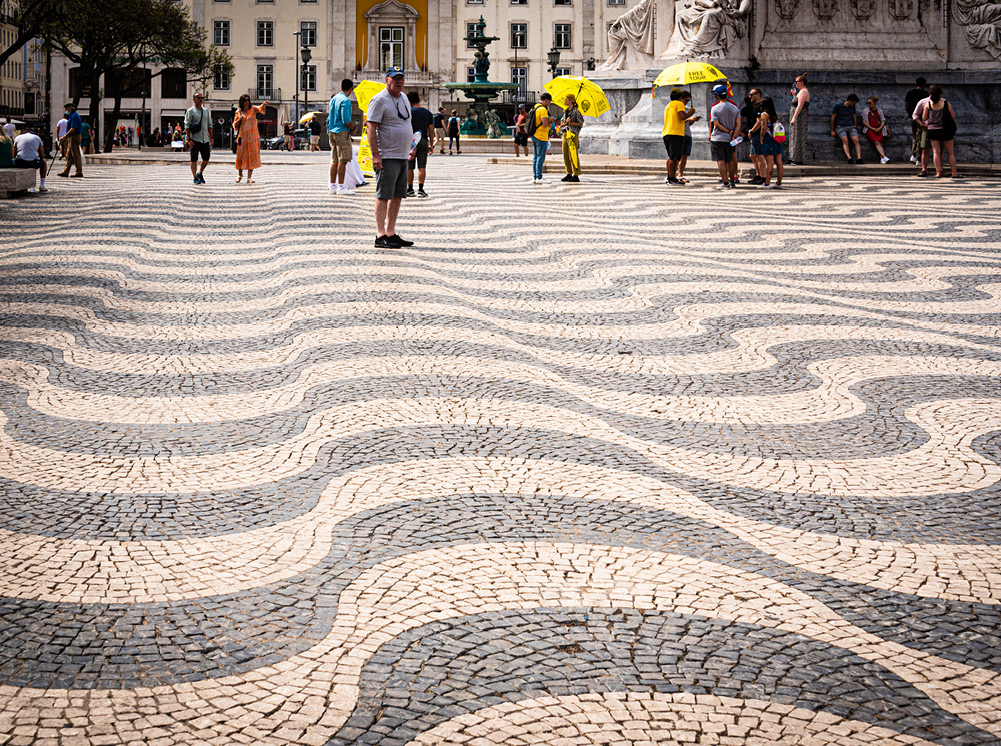
Lisbon—Where Have You Been All My Life?
We spent the first three days, with Joël as our guide at times, climbing about the hilly cobblestoned neighborhoods of old Lisbon that line up along the Tagus River: Baixa with its grand plazas and historical monuments; Chiado, a trendy shopping and dining district; Bairro Alto, bars and nightclubs coming alive at night; and photogenic Alfama, the oldest of all the neighborhoods.
Alfama was the only neighborhood that escaped the devastating massive 1755 earthquake and tsunami that destroyed the rest of Lisbon. Its narrow pedestrian-only lanes and steps were built for residents to negotiate Alfama’s steep hill. These steps, punctuated with small plazas for neighborhood events and festivities, wind between medieval homes and small stores. One evening in Alfama we experienced a performance of fado, a popular form of music native to Portugal, in a residential home turned into a small restaurant and impromptu performance space. Mom and her daughters hosted and served us––or so it seemed to me. The two-person group, a guitar player and vocalist, sang mournful, melancholy tunes and lyrics that tell stories of life’s difficulties for mostly the poor and for the sailors during Portugal’s seafaring heyday. I found the music beautiful and haunting.
Scattered throughout hilly old Lisbon, lookouts (called miradouros) attract crowds for their panoramic views of the beautiful town. The vistas of red-tiled roofs, church spires, noble eighteenth century public buildings, and the Tagus River at the city’s edge entranced me. (At one miradouro in Bairro Alto, mesmerized by the scene, I succumbed to a “hustle” by a friendly young trinket-selling man whose family in Angola “sends him bracelets of semi-precious stones.” I got away with giving up only €10, roughly $10.)
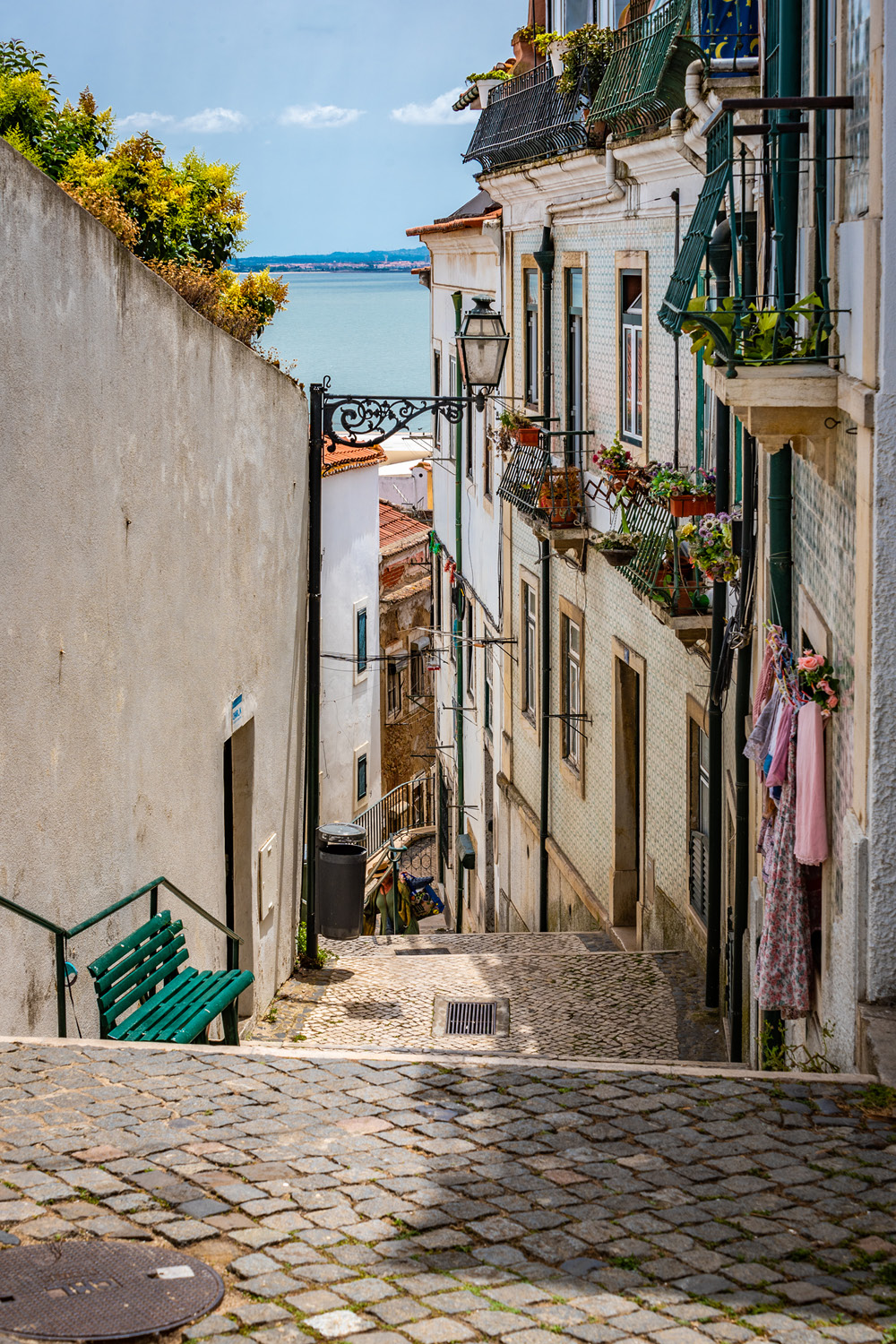

It never crossed my mind that someday I would eat gooseneck barnacles, those unappealing crustaceans from the same family as those attached to boats, whales, crabs, and lobsters. But Joël ordered them for us at one of the popular local seafood hangouts where reservations are a “must,’ unless you know the owner, as Joël did. He introduced us to Portugal’s everyday delicious fish and seafood cuisine at Cervejaria Ramiro in the Anjos neighborhood near downtown. (Cervejaria means brewery.)
The barnacles were…unusual to eat, squirting juice over everything and everybody nearby as I twisted off the hard shell to get to the meat. I couldn’t get my fill of the tiny clams steamed in butter, garlic, and cilantro, and the giant prawns, a good seven inches long, split and grilled. They disappeared all too quickly, washed down with two glasses of restaurant’s own brew. More clams, please.
One day we rode commuter trolley Tram 28 that winds through several of these communities. We boarded the already crowded trolley at the Basilica da Estrela across from Estrela Garden late morning (get there earlier than we did—more tourists than we expected!) and traveled east, up and down steep city streets to Praça Martim Moniz. The square’s surrounding community serves as home to an Asian population and other immigrant groups, many from Portugal’s former colonies. The exciting Tram 28 ride gave us another perspective of Lisbon’s picturesque neighborhoods as we watched Lisboetas go to work and carry on with their day’s business.
Lisbon’s Nearby Coastal Towns—Cascais and Sintra
Joël picked us up one morning and we headed west towards the nearby Atlantic Ocean. First stop: the resort town of Cascais, once a humble fishing village. Now a popular beach resort, Cascais still sports a harbor of fishing boats bobbing in the water and containers of nets, buoys, and fishing gear spread across the sand. Moving north along the coast, we encountered spectacular views of ocean waves crashing against sheer 100-foot-high cliffs displaying nature’s drama, as we stood at the western most point of continental Europe.
Simply prepared edibles from the sea are highlights of Portuguese cuisine in cities near the ocean. From left: gooseneck barnacles, baby clams with garlic and cilantro, and giant prawns, the last cooked on very high heat to crisp the edges.
The Atlantic Ocean crashes against the sheer cliffs of continental Europe’s westernmost land mass, not far from Lisbon. The nearby old lighthouse, now a gift shop, warned ship captains about treacherous waters.
After experiencing the ocean’s majestic fury and energy, Joël knew a good maritime lunch would fuel us before our next stop. Tucked along the rocky coast, Praia da Adraga, a restaurant named after the gorgeous beach where it’s located, provided another gustatory experience. Joël ordered a blackbelly rosefish (cantaril) for the table, a deep-sea dweller found in the Azores, an archipelago of islands in the Atlantic Ocean that belong to Portugal. The rich and flavorful white and flaky cantaril was one of the most delicious fish I’ve eaten.
Highlight of the day’s journey—the town of Sintra’s UNESCO World Heritage-designated Palácio Nacional da Pena. (UNESCO stands for United Nations Educational, Scientific, and Cultural Organization.) A whimsical palace in appearance, its exterior shows off vivid shades of yellow and red. Its interior restored to its appearance in 1910, the palace stands still at the time when Portuguese nobility fled the country as a republican coup threw out the centuries-old monarchy.
I was busy snapping photos from one of the balconies, when a young Portuguese man approached me nervously. He wanted to surprise his Brazilian girlfriend with a marriage proposal. He handed me his cellphone and asked if I would make a video of the event. With cameras rolling, I followed him as he lowered himself on one knee, fumbled as he fished the ring from his pocket, and asked the question. A tear rolled down her cheek as she nodded her head. (Tears filled my eyes, too.) What a gift to bear witness.
Travelers: put Sintra’s palace close to the top of your “must-see” list when you visit Lisbon and allow up to a full day. In Sintra’s pine forest, other palaces, ruins of a tenth century Moorish castle, and lavish villas dot the landscape, but we didn’t allot enough time to visit them.
